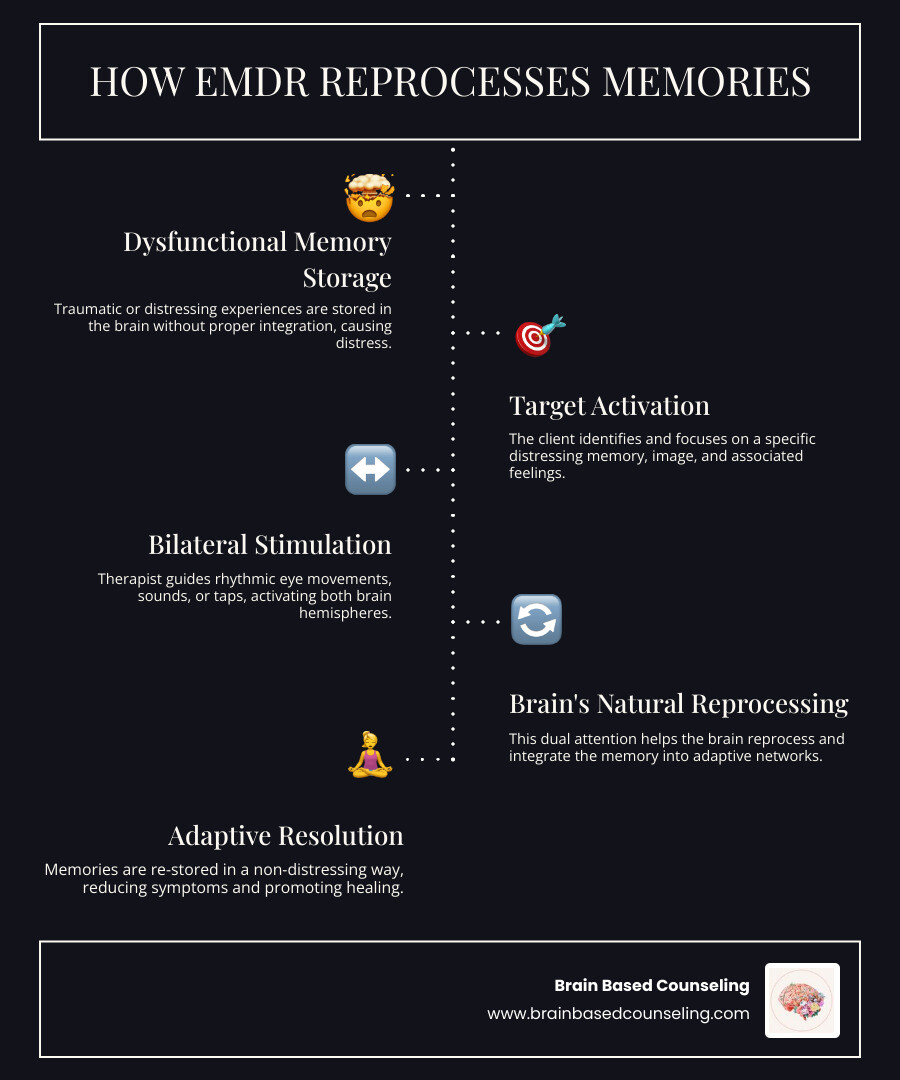Eye Movement Desensitization and Reprocessing: A Comprehensive Guide

Understanding Eye Movement Desensitization and Reprocessing (EMDR)
Eye Movement Desensitization and Reprocessing (EMDR) represents a revolutionary approach to healing trauma and emotional distress. This evidence-based therapy works with your brain's natural processing systems to transform how traumatic memories and distressing life experiences are stored and experienced, offering a path to profound emotional freedom without requiring you to relive traumatic events in detail.
Developed by Dr. Francine Shapiro in 1987, eye movement desensitization and reprocessing has evolved into a gold-standard treatment recognized by major health organizations worldwide, including the World Health Organization and the American Psychiatric Association. Unlike traditional talk therapy approaches, EMDR therapy uses bilateral stimulation—typically guided eye movements—to help your brain reprocess "stuck" traumatic memories that continue to cause anxiety, panic, nightmares, or persistent emotional patterns.
At Brain Based Counseling, I specialize in EMDR intensive therapy, providing concentrated healing sessions that accelerate progress for motivated individuals seeking transformative change. Located near Cincinnati's affluent communities of Indian Hill, Madeira, Mason, Hyde Park, Mount Lookout, Mount Adams, and Terrace Park, my practice offers personalized, science-backed EMDR treatment for women with high-functioning anxiety, individuals experiencing betrayal trauma, and first responders seeking deep emotional healing through movement desensitization and reprocessing.
The Science Behind EMDR: How Your Brain Naturally Heals
Eye movement desensitization and reprocessing therapy is grounded in the Adaptive Information Processing (AIP) model, which recognizes that your brain possesses an innate capacity for healing and integration. When functioning optimally, your brain processes difficult experiences and files them away as completed memories. However, traumatic events or overwhelming experiences can disrupt this natural healing process, causing traumatic memories to become "frozen" with their original emotional intensity, physical sensations, and negative beliefs intact.
These unprocessed disturbing memories continue to trigger intense reactions in your present life, often manifesting as anxiety disorders, hypervigilance, intrusive thoughts, or deeply held negative beliefs about yourself or the world. EMDR therapy gently reactivates your brain's processing system through bilateral stimulation, helping move these stuck trauma memories from their emotionally charged state into your integrated memory network.
The goal of movement desensitization and reprocessing isn't to erase what happened, but to change how these traumatic experiences affect you today. Through this neuroscience-informed approach, painful disturbing memories lose their emotional grip, allowing you to access your natural resilience and wisdom while reducing negative emotions and physical discomfort associated with past trauma.
EMDR Intensive Format: Accelerated Healing for Busy Professionals
Traditional weekly therapy sessions can extend healing journeys over many months or years. EMDR intensive therapy offers a different path—one that respects your time while maximizing therapeutic impact. These concentrated EMDR sessions span 1-3 consecutive days, with 4-6 hours of focused EMDR treatment per day, creating an immersive healing environment that allows for deeper processing of traumatic memories without weekly interruptions.
This intensive format is particularly effective for high-achieving professionals who value efficiency and results. Rather than managing therapy appointments week after week, you can make substantial progress in fewer sessions, often experiencing significant relief and lasting change more quickly than traditional formats allow through successful EMDR therapy.
The intensive approach also creates optimal conditions for your brain's natural healing process. Without the start-stop nature of weekly sessions, your nervous system can move through the complete processing cycle, leading to more thorough integration and sustainable results when treating post traumatic stress disorder and other mental health conditions.

Who Benefits from EMDR Intensive Therapy
Women with High-Functioning Anxiety
Many accomplished women carry an invisible burden of anxiety that contradicts their external success. Despite professional achievements and seemingly perfect lives, you may struggle with persistent worry, perfectionism, self-doubt, or an inner critic that never seems satisfied. These anxiety disorders often stem from earlier experiences—perhaps childhood messages about needing to be perfect, academic or social pressures, or accumulated "small t" traumatic experiences that were never fully processed through eye movement desensitization.
EMDR intensive therapy can target the root traumatic memories driving these anxious patterns, helping you develop genuine confidence and inner peace that matches your external accomplishments. The concentrated format allows for comprehensive processing of multiple related disturbing memories, creating lasting shifts in how you experience yourself and your capabilities while reducing negative emotions and disturbing thoughts.
Betrayal Trauma Recovery
Betrayal trauma occurs when someone you depend on for survival or emotional well-being violates your trust in a significant way. This form of trauma creates unique mental health challenges because it damages not only your sense of safety but also your ability to trust your own perceptions and judgment.
EMDR intensive therapy provides a powerful framework for processing the shock, grief, anger, and confusion that accompany betrayal through eye movement desensitization and reprocessing techniques. The concentrated format allows for thorough processing of the multiple layers of betrayal trauma—from the initial disturbing event through the ongoing impact on your sense of self and relationships. This comprehensive EMDR treatment helps restore your ability to trust yourself and others appropriately while rebuilding a secure foundation for future relationships.
First Responder Trauma and Resilience
First responders face unique psychological challenges, including exposure to critical incidents, cumulative stress from repeated trauma exposure, and organizational pressures that can contribute to burnout and compassion fatigue. Traditional therapy approaches may feel inadequate for the intensity and complexity of these experiences when treating PTSD symptoms and other mental health conditions.
EMDR intensive therapy offers first responders a concentrated opportunity to process both specific critical incidents and the cumulative impact of their demanding careers through movement desensitization and reprocessing. The intensive format respects the reality of shift work and busy schedules while providing thorough trauma treatment that can restore resilience and prevent long-term psychological injury from posttraumatic stress disorder.

The Eight-Phase EMDR Protocol: Your Roadmap to Healing
Eye movement desensitization and reprocessing therapy follows a structured eight phases protocol that ensures safety, thoroughness, and lasting results. Each phase serves a specific purpose in your healing journey, while remaining completely personalized to your unique experiences and goals. This eight phases framework has been refined through decades of clinical practice and ongoing research.
Phases 1-2: Foundation Building
Phase 1 (History Taking) begins with understanding your story, current struggles, and healing goals. Together, we identify specific traumatic memories or experiences causing distress and create a personalized EMDR treatment plan tailored to your needs. As your EMDR therapist, I'll assess your readiness for processing traumatic experiences and ensure you meet the criteria for successful EMDR therapy.
Phase 2 (Preparation) focuses on building your capacity for the work ahead. I'll explain the eye movement desensitization and reprocessing process thoroughly, strengthen your coping skills, and help you develop internal resources like a mental "safe place" you can access whenever you need grounding. This phase ensures you feel confident and in control before processing any disturbing memories through bilateral stimulation.
Phases 3-6: Core Memory Processing
Phase 3 (Assessment) involves activating the target memory by identifying a key image, the negative belief it carries about you (such as "I am powerless"), and a positive belief you'd rather hold (like "I have choices now"). We measure the memory's disturbance level and how true the positive belief feels, establishing baselines for tracking progress during EMDR treatment.
Phase 4 (Desensitization) is where the bilateral stimulation occurs through eye movements or other techniques. While you hold the disturbing memory in awareness, I guide you through sets of lateral eye movements that facilitate the natural healing process. After each set, you notice what emerges—thoughts, images, emotions, or body sensations. This allows your brain's processing system to reduce the memory's emotional intensity and associated negative emotions.
Phase 5 (Installation) focuses on strengthening the positive belief once distress has diminished. Using additional bilateral stimulation and eye movements, we help this adaptive belief feel completely true and integrated, replacing negative thoughts with healthier perspectives about yourself and your capabilities.
Phase 6 (Body Scan) recognizes that trauma is held in the body through physical sensations and bodily sensations. I guide you through scanning your body for any residual tension or body sensations related to the memory, using bilateral stimulation to resolve any remaining activation and physical discomfort.
Phases 7-8: Integration and Stability
Phase 7 (Closure) ensures you feel calm and grounded at each session's end. If a memory isn't fully processed during EMDR sessions, I guide you through specific techniques to contain any activation until our next meeting, ensuring your safety between appointments.
Phase 8 (Re-evaluation) begins subsequent sessions by checking on previously processed traumatic memories to ensure positive changes have held and identifying any new targets that may have emerged. This phase helps maintain the gains from successful EMDR therapy.
What Makes EMDR Different from Traditional Talk Therapy
Eye movement desensitization and reprocessing offers several distinctive advantages over conventional therapeutic approaches for treating mental health conditions:
Less Talking, More Processing: You don't need to describe traumatic experiences in detail. The focus remains on your internal experience during bilateral stimulation and eye movements, allowing healing without extensive verbal recounting of disturbing events.
Body-Based Integration: EMDR therapy recognizes that trauma lives in your body through physical sensations and bodily sensations, not just your mind. The therapy works directly with these somatic responses for more complete healing than talk therapy alone.
Accelerated Results: By working directly with your brain's natural processing capacity through eye movement desensitization, EMDR treatment often produces more rapid shifts than approaches requiring extensive analysis or interpretation, often requiring fewer sessions than other therapies.
Dual Attention: You maintain awareness of present-moment safety while focusing on past traumatic memories. This dual awareness prevents overwhelming re-experiencing while allowing therapeutic processing of disturbing memories.
Client-Led Healing: Your brain generates the insights and emotional shifts that lead to healing through the natural healing process. My role as your EMDR therapist is to guide the process and ensure your safety, not interpret your experience or direct specific outcomes.

The Evidence Base: Research Supporting EMDR
The effectiveness of eye movement desensitization and reprocessing is supported by extensive research spanning over three decades. More than 30 controlled studies demonstrate its remarkable efficiency for trauma treatment, with some studies showing that 84-90% of single-trauma victims no longer meet criteria for post traumatic stress disorder after just a few EMDR sessions.
For individuals with complex trauma histories, including combat veterans and multiple-trauma survivors, ongoing research consistently shows significant improvement in PTSD symptoms and other mental health conditions in a relatively brief timeframe compared to other therapies. These aren't merely statistical improvements—they represent people reclaiming their lives from the grip of posttraumatic stress disorder and trauma memories.
Major health organizations worldwide recognize EMDR therapy as an effective treatment for treating PTSD and other mental health conditions:
- The World Health Organization (WHO)
- The American Psychiatric Association (APA)
- The Department of Veterans Affairs and Department of Defense
- The International Society for Traumatic Stress Studies (ISTSS)
This broad consensus, supported by clinical practice guidelines, reflects what I witness in my EMDR practice: movement desensitization and reprocessing works remarkably well for motivated individuals committed to their healing journey from past trauma.
What to Expect in Your EMDR Intensive Experience
Many people worry that EMDR therapy will force them to relive trauma, but you remain in complete control throughout the process. The experience resembles watching a memory from a safe distance while I guide the eye movement desensitization and reprocessing process and ensure you feel grounded and secure.
Every session is personalized to your needs, pace, and comfort level. The process follows your brain's natural wisdom, allowing for organic and transformative healing without forced outcomes or predetermined timelines. A typical EMDR therapy session includes preparation, bilateral stimulation through eye movements, and integration of insights gained through reprocessing therapy.
Session Structure and Intensive Format
While traditional EMDR occurs in 60-90 minute weekly sessions, EMDR intensive therapy dedicates longer, concentrated blocks of time to the healing process. This format accelerates progress by allowing deeper processing of traumatic memories without weekly interruptions, enabling you to make significant strides in fewer sessions overall.
The intensive format is particularly effective for complex issues like betrayal trauma or the accumulated "small t" traumatic experiences often underlying high-functioning anxiety and anxiety disorders. By maintaining therapeutic momentum over consecutive days, your brain can complete full processing cycles of disturbing memories that might take months in traditional weekly therapy.
The number of EMDR sessions needed varies based on your unique history and goals. Single traumatic events may resolve in a few intensive sessions, while more complex presentations involving multiple disturbing events may require additional time. There is no universal timeline—your EMDR treatment plan is customized to your specific healing objectives and mental health needs.

The Body Scan: Integrating Physical and Emotional Healing
A distinctive aspect of eye movement desensitization and reprocessing therapy is the incorporation of body scanning, which plays a crucial role in processing traumatic memories on multiple levels. After bilateral stimulation and eye movements, you're guided to notice any physical sensations—tension, discomfort, changes in breathing—that may be connected to the memory being processed.
This body awareness helps identify and release residual distress stored in your physical being through attention to body sensations and bodily sensations. The body scan ensures complete memory reprocessing while fostering greater relaxation and well-being, addressing both negative emotions and physical discomfort. Through EMDR intensive therapy, you learn to recognize and release trauma's physical manifestations, supporting both emotional and somatic healing from past disturbing experiences.
Advanced Applications: Beyond Post Traumatic Stress Disorder
While eye movement desensitization and reprocessing initially developed to treat post traumatic stress disorder, ongoing research has expanded its applications to numerous other mental health conditions. EMDR therapy has shown effectiveness for anxiety disorders, depression, obsessive compulsive disorder, eating disorders, and dissociative disorders when these conditions are rooted in unprocessed traumatic experiences.
The versatility of movement desensitization and reprocessing stems from its focus on addressing the underlying disturbing memories that contribute to various mental health challenges. Rather than just managing symptoms, EMDR treatment targets the root experiences that fuel ongoing emotional distress, negative thoughts, and maladaptive beliefs.
Current ongoing research continues to refine EMDR practice and explore new applications. While EMDR controversial debates existed in early years, decades of clinical practice guidelines and evidence have established its credibility as an effective treatment for trauma and related mental health conditions.
Choosing EMDR Intensive Therapy: Is It Right for You?
Eye movement desensitization and reprocessing intensive therapy may be an excellent fit if you're a motivated individual ready to invest in your mental well-being. This approach works particularly well for high-achieving professionals who value efficiency and are committed to doing the necessary work for lasting change through successful EMDR therapy.
You might benefit from EMDR intensive therapy if you:
- Experience anxiety disorders that seem disproportionate to your current circumstances
- Struggle with negative beliefs about yourself despite external success
- Have experienced betrayal that continues to impact your relationships and self-trust
- Are a first responder dealing with critical incident stress or cumulative trauma from traumatic events
- Feel stuck in emotional patterns that traditional talk therapy hasn't fully resolved
- Prefer a concentrated, results-oriented approach to processing traumatic memories
- Value privacy and personalized care from an experienced EMDR therapist
Getting Started: Your Path to Healing
Beginning your eye movement desensitization and reprocessing intensive journey starts with a comprehensive consultation process designed to ensure this approach aligns with your needs and goals. After your initial contact, I'll reach out to schedule a 20-minute consultation call where we can discuss your situation and determine if EMDR therapy is appropriate for your healing objectives.
If you decide to move forward, you'll receive detailed intake paperwork, informed consent documents, practice policies, and pre-screening forms specific to EMDR intensive therapy. During your intake appointment, we'll review all policies and procedures while evaluating your readiness and stability for intensive work with traumatic memories and disturbing events.
I complete a comprehensive clinical intake—an in-depth interview that helps me understand your unique history and current mental health needs. Together, we'll formulate a personalized EMDR treatment plan before beginning any intervention work, ensuring you feel fully prepared and confident about the movement desensitization and reprocessing process ahead.
Your Healing Journey Begins Here
Eye movement desensitization and reprocessing intensive therapy offers more than symptom relief—it provides a pathway to genuine emotional freedom and lasting change. By working with your brain's natural healing process, this evidence-based approach can transform sources of ongoing distress from traumatic memories into integrated experiences that no longer control your present life.
This isn't about forgetting what happened or minimizing your traumatic experiences. It's about freeing yourself from trauma's grip through eye movements and bilateral stimulation so you can live more fully in the present, accessing your natural resilience and wisdom while reducing negative emotions and disturbing thoughts.
At Brain Based Counseling, I provide specialized EMDR intensive therapy from a convenient Cincinnati-area location serving the communities of Indian Hill, Madeira, Mason, Hyde Park, Mount Lookout, Mount Adams, and Terrace Park. For clients in North Carolina, I offer secure virtual EMDR sessions that provide the same personalized, results-oriented care for treating posttraumatic stress disorder and other mental health conditions.
Your healing journey through eye movement desensitization and reprocessing is uniquely yours, and I'm committed to providing the individualized, science-backed support you deserve. As a solo practitioner specializing in trauma treatment and resilience, I can offer the focused attention and personalized care that makes lasting change possible through successful EMDR therapy.
Ready to discover your brain's natural healing potential through movement desensitization and reprocessing? Contact Brain Based Counseling today to learn more about EMDR intensive therapy and take the first step toward the emotional freedom you've been seeking. Your transformation through eye movement desensitization awaits.
